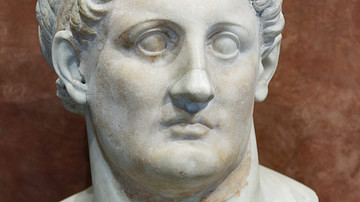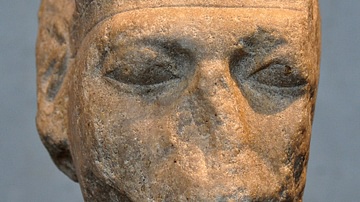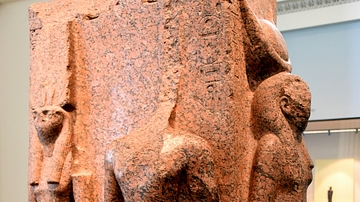Search
Did you mean: Darius I?
Search Results

Definition
Faravahar
The faravahar is the best-known symbol from ancient Persia of the winged sun disk with a seated male figure in the center. It is thought to represent Ahura Mazda, the god of Zoroastrianism, but has also been interpreted to signify other concepts...

Definition
Argead Dynasty
The Argead dynasty, the ancient Macedonian house of Dorian Greek origin, lasted from the 7th century to 310 BCE. The mythological founder of the dynasty was King Caranus but it was under Philip II of Macedon (382-226 BCE) that the Macedonian...

Image
Richard III Woos Lady Anne - Richard III, Act I Scene II
Richard III of England woos Lady Anne Neville in Act I Scene II of William Shakespeare's The Tragedy of Richard III (c. 1594), drawing by Herbert Railton, circa 1890.
Folger Shakespeare Library.

Image
Captured Flocks from Arab Enemies of Tiglath-pileser III
Sheep and goats, captured in a campaign against the Arabs are driven back to the Assyrian camp. This scene decorated the palace of King Tiglath-pileser III (reigned 744-727 BCE. Assyrian, about 728 BCE. From the Central Palace at Nimrud (ancient...

Image
King Tiglath-pileser III
An alabaster bas-relief depicting the Assyrian king Tiglath-pileser III. From the central palace, Nimrud (ancient Kalhu), Mesopotamia, northern Iraq. Neo-Assyrian era, circa 728 BCE. (The British Museum, London)

Image
Tiglath-pileser III, Submission of Enemy
An alabaster bas-relief depicting the Assyrian king Tiglath-pileser III stands over a captured enemy. The cuneiform inscription describes an Assyrian campaign in Iran 744 BCE. From the central palace at Nimrud (ancient Kalhu), reused and...

Definition
Ptolemy I
Ptolemy I Soter (366-282 BCE) was one of the successor kings to the empire of Alexander the Great. He served not only as king of Egypt but also the founder of the Ptolemaic Dynasty, a dynasty which included the infamous Cleopatra VII. Early...

Image
Richard III is Tormented by the Ghosts of His Victims - Richard III, Act V, Scene III
Richard III of England is tormented by the ghosts of his victims on the eve of his death at the Battle of Bosworth, in Act V Scene III of William Shakespeare's play The Tragedy of Richard III (c.1594), watercolors by Alexandre Bida, 1893...

Image
Pharaoh Senusret III
Quartzite head of the Egyptian pharaoh Senusret III (aka Sesostris III) with aged features. Middle Kingdom, 12th Dynasty, 1850 BCE. (State Museum of Egyptian Art, Munich, Germany).

Image
Sculpture of King Thutmose III
This is a rare example of an Egyptian temple sculpture, in which the figures face in 4 different directions. This suggests that it stood in the middle of a room. Three persons are represented twice. King Thutmose III (now headless) stands...